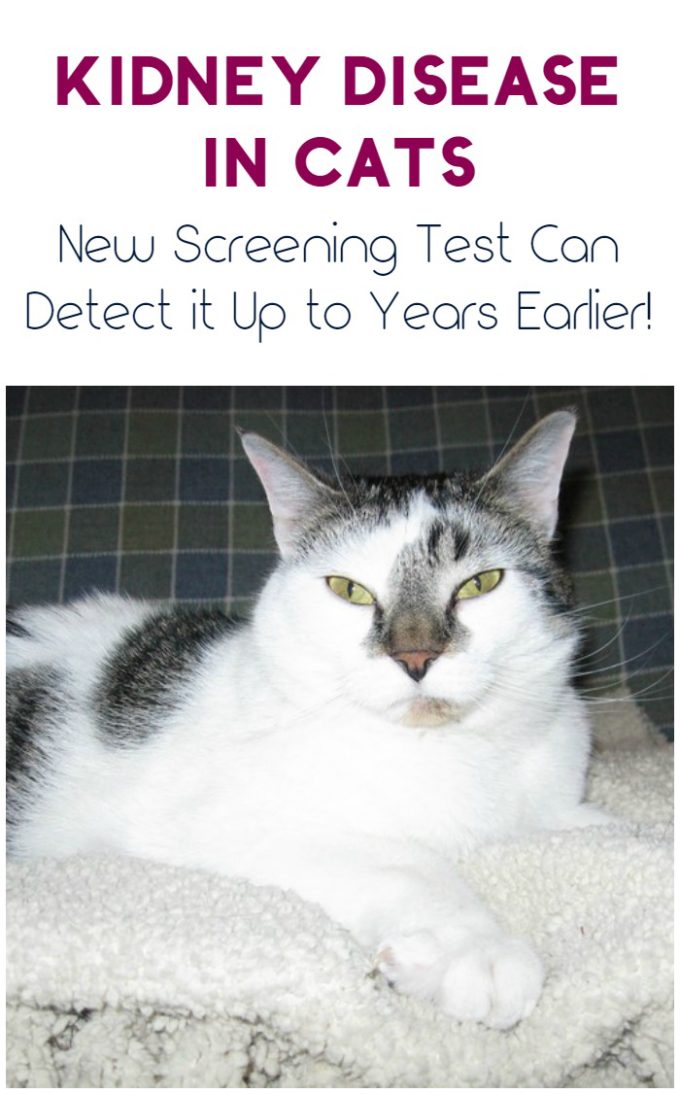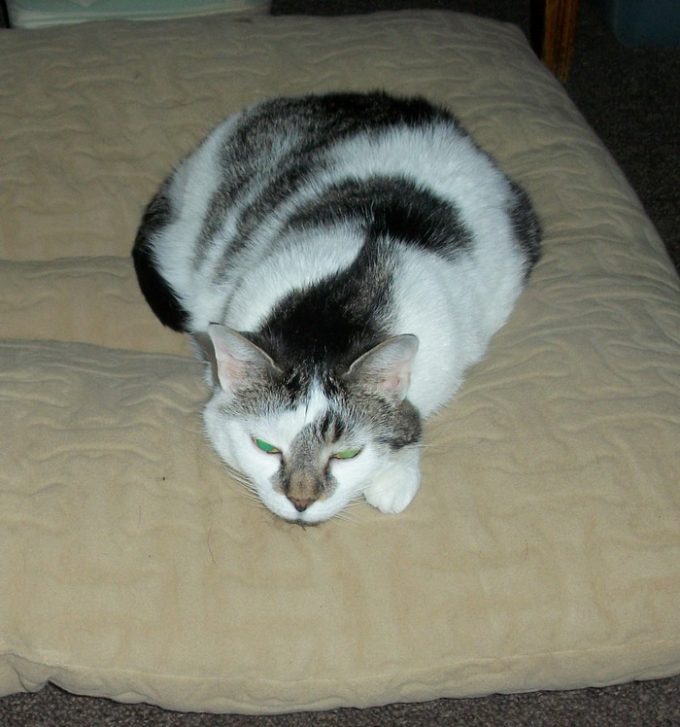This post is sponsored by Pet Health Network® and the BlogPaws® Pet Influencer Network™. I am being compensated to help create awareness for the importance of the IDEXX SDMA™ kidney screening test for pets, but I only share information I feel is relevant to my readers. Neither Pet Health Network® or IDEXX is responsible for the content of this article.
If you could detect kidney disease in your cat well before it wreaked havoc on her health, would you do it? I know I would. Up until recently, I never gave a lot of thought about kidney disease in cats. It just didn’t cross my mind. I’ve dealt with other issues: feline diabetes, cat acne, even cats that were allergic to each other. But kidney disease? It just wasn’t on my radar.
Then our cat Prue started to lose weight. It was subtle at first. Prue has always been a long and lanky cat, but we noticed that she seemed a bit more drawn in the face. At first, we thought it was due to her dental issues. Prue has some sort of genetic issue that has caused a lot of problems with her teeth. She’s had several pulled over the years, and when one is bothering her, she eats less (makes sense, right?). We took her to the vet, they pulled another tooth, gave her antibiotics and sent us home.
Months later, Prue started losing weight again. She’d gain, she’d lose. She’d get really sick for a while, then bounce back. We were seeing multiple vets at the time. We used to have an amazing vet, but sadly, he passed away. Every vet seemed to tell us something different. It wasn’t until recently that we finally found a new vet that we really like, and he suggested that Prue may have kidney disease. At this point, we’re doing the best we can to keep her healthy. Right now, she’s on an upswing. Sadly, though, I’m afraid that waiting so long for the right diagnose may have significantly shortened Prue’s lifespan.
If I knew there was a test that could determine her risk of kidney disease months, or even years, earlier, I definitely would have gotten in.
The Facts About Kidney Disease In Cats

Image courtesy of IDEXX”
Did you know that 1 in 3 cats will develop some form of kidney disease throughout their lifetime? That means, statistically speaking, one of those three kitties in that adorable picture will be affected. The scary part? Most cats don’t show any major signs until the advances stages of the disease.
Kidney disease is to cats what heart disease is to us. It’s a leading cause of suffering and death in our feline companions. Like heart disease, it’s often silent…until it’s not. While kidney disease can strike at any age, your cat’s risk of developing it increases as they get older. More than half of all cats over age 15 are affected. Prue is just about 13.
How Can the New IDEXX SDMA™ Screening Test Help Catch it Early?
IDEXX SDMA™ is a new screening test for cats and dogs that can detect kidney disease months to years earlier, giving you a chance to do something about it. For cats, the test can even detect the disease before it affects kidney function. Think of it this way: your doctor tests your cholesterol regularly to help head off heart disease, right? Well IDEXX SDMA™ is like that, except for kidney disease in pets.
The “SDMA” stands for symmetric dimethylarginine. I’m not great at explaining science stuff, so bear with me here for a minute. Basically, SDMA is a chemical in your cats body that’s left over after other nutrients are broken down, and it’s primarily processed through the kidneys. Working kidneys process it pretty well, so the levels will be within normal range. SDMA increases earlier than creatinine in Chronic Kidney Disease. SDMA increases on average with 40% loss of kidney function versus creatinine, which does not show an increase until 75% of kidney function is lost.
The alternative test for determining kidney function look at your cat’s creatinine levels. Unfortunately, those levels really only spike enough to send up warning flags when your cat’s kidneys are already functioning at 75% less than optimal level. Not until much more advanced stages of Chronic Kidney Disease.
According to our vet, for thinner cats like Prue, testing creatinine levels becomes even less reliable. SDMA is specific for kidney function. It is not impacted by extrarenal factors (layman’s terms: factors outside the kidneys) that impact creatinine. In particular, it is not impacted by lean body mass so it will more accurately reflect GFR in underweight dogs and cats (like geriatric felines or pets with cancer).
Testing SDMA level gives you a chance to find out much earlier, typically when your cat’s kidney function is only 40% affected. This gives you a much better chance of coming up with the right treatment plan with your vet’s help.
IDEXX SDMA™ is available through your veterinarian. If you think there’s even a chance your cat could be showing signs of kidney disease, make an appointment right now. Otherwise, talk to your vet at your cat’s next routine appointment to request the screening test. The earlier we can catch this disease, the better chance our feline friends have of remaining a part of our lives for years to come.
Learn more about kidney disease in pets and how IDEXX SDMA™ works. Visit their Facebook page to keep up with news.
Ask your veterinarian for the IDEXX SDMA™ kidney screening test.
T
This is a sponsored conversation written by me on behalf of Pet Health Network®. The opinions and text are all mine.






It’s wonderful that this is available now. All cat owners need to know about this.
This is awesome news for cat lovers. Being a responsible pet owner does not only mean feeding our pets. We should also be vigilant to notice health issues that may point to serious illnesses.
I wish we had the energy and time for a pet. I miss having a dog! We could never be cat people because I am allergic and I am pretty sure our son could be!
Having animals takes a lot of time and responsibility and unfortunately, we do not have that to spare!
Thanks for sharing the info on IDEXX SDMA™ . I love my cat just like I do any other family member. I’d hate for her to suffer from kidney disease or anything else.
I’m more a dog person, but I’m glad to hear this new test can help cat pet owners. We pet parents are always looking for ways to keep our pets healthy.
This new test will prevent so many people from losing their sweet pets early, and this is incredibly amazing! <3
This would be so helpful considering I have 2 cats that are 15 years old.
Wow, great to hear that they already came up with a screening test like this. Cats are one of the loveliest and sweetest on earth!
I didn’t know they could be prone to such a disease. It’s good to have options and to know what to do if this happens to your beloved fur baby.
Oh, I hate to see pets from suffering. Good thing we have such screening test like this, hope that it is not expensive.
This could save many lives of cats around the world. Glad to hear about this screening test, thanks for sharing!
I never had pets but in a way I have an idea how it feels if one is sick. I am glad this things come in handy.
I have never had anything but a bird and do not want him to get sick. I have seen my parents dogs become sick and it is not good. They become part of your family . I am happy to hear about the screen testing of cats though! Anything to make them live longer and healthier!
Such an informative post.I don’t have cats but will share this with my friends who have cats
Thanks for sharing this information about cats kidney disease, am sure those with cats will appreciate it!
This is so great to know. Cat owners and lovers can surely benefit from this breakthrough.
That’s great that they can find this sooner. I have two cats and I couldn’t imagine them having any disease. I’m glad that they have these tests out there to help.
It’s wonderful that this is available now. Could save a lot of kitties lives!
omg reading your blogpost makes me stop thinking to not have a pet since my daughter wants one. but things like this sounds like a no go for me. Although It is very nice to know that you can detect things like this for cats which can be a good idea for pet owners
This is good to know. A friend of mine just adopted a cat from a shelter, I will be sue to share this with her. Do not forget today is #NationalHugYourCatDay
Thank you for your insight, I also have an elderly cat at 17 years. Misty was loosing weight a couple of years ago and my astute vet picked up that she had a throid problem & felt it may have been masking a kidney disease. He was right. The vet told me 2.5 years ago Misty may not make it to Xmas. With the right care & lots of love Misty lives a great life. With loosing some weight she developed an eye irritation an had her procedure Botox on her eyes recently, and is a new girl again.